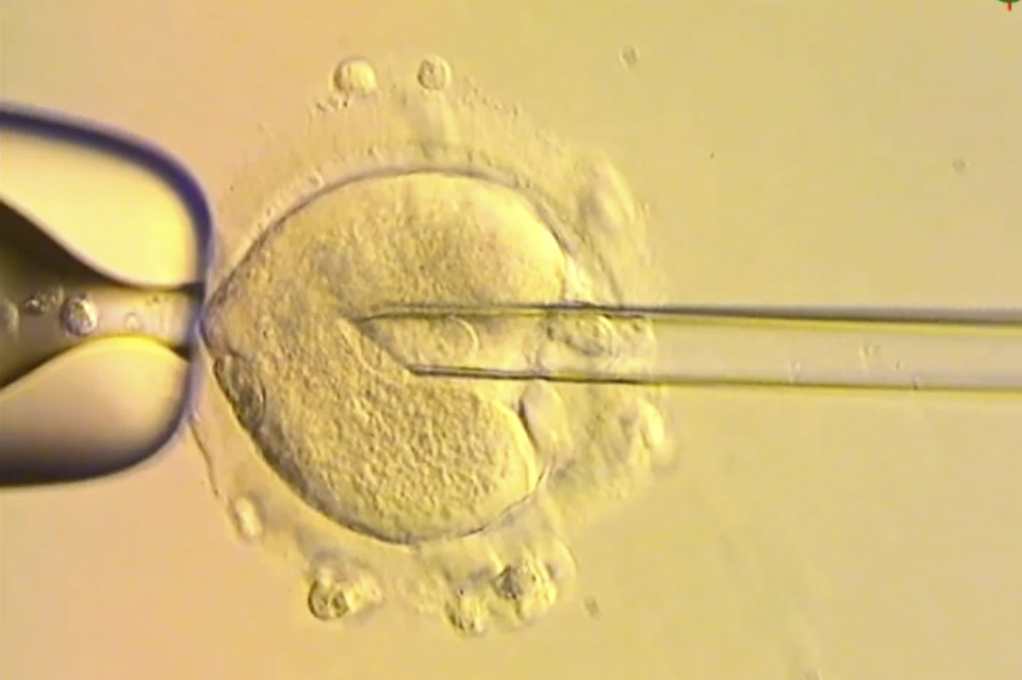
©(Newcastle Fertility Centre, Newcastle Hospitals NHS Foundation Trust via AP)
Vocabulary:
I will read the words, meanings, and sample sentences. Then, repeat after me.
- mitochondrial /mahy-tuh-KAHN-dree-uhl/
- devastating /DEV-uh-stey-ting/
- seizure /SEE-zher/
- triumph /TRAHY-uhmf/
- heritable /HER-i-tuh-buhl/
[adjective] – relating to mitochondria (the parts of a cell that produce energy)
Scientists are developing treatments for mitochondrial conditions that affect the heart.
[adjective] – causing great damage or suffering
The new vaccine protects people from devastating infectious diseases.
[noun] – sudden, uncontrolled electrical activity in the brain that causes changes in behavior, movement, or consciousness
The child was taken to the hospital after having seizures during the night.
[noun] – a great victory or achievement
The scientist’s discovery was a triumph for cancer research.
[adjective] – able to be passed from parents to children through genes
Some heritable conditions, like color blindness, run in families.
Article reading:
Please read the whole article. Then, I will check your pronunciation and intonation.
A medical team in the United Kingdom successfully used a new reproductive technique to allow eight healthy babies to be born without mitochondrial diseases. The findings were reported on July 16, 2025, in the New England Journal of Medicine. The method aims to prevent mothers from passing rare and devastating mitochondrial diseases to their children. These diseases, caused by damaged mitochondria, can lead to severe health problems such as muscle weakness, seizures, organ failure, and fatality. The use of this technique received official approval in the United Kingdom in 2016. Australia has also legalized the method, while it continues to be banned in multiple countries, including the United States. According to the study, scientists applied the procedure to fertilized embryos from 22 patients, leading to the birth of eight babies without signs of mitochondrial disease. One additional pregnancy is ongoing.
The technique is called mitochondrial replacement therapy. It involves transferring the mother’s DNA into a healthy donor egg that contains functioning mitochondria, while the donor’s original genetic material is removed. This advanced procedure creates an embryo that carries genetic material from three individuals: the mother, the father, and a donor. According to scientists, the donor DNA represents less than 1% of the baby’s total genetic composition, which means there is no risk of inheriting physical traits from the donor. Experts described the achievement as a “triumph of scientific innovation,” stating that it offers a new solution for families affected by severe genetic risks. However, some experts have warned about possible long-term consequences for future generations due to the heritable nature of the modification. In the United Kingdom, each case must receive approval from the Human Fertilisation and Embryology Authority before treatment can proceed.
The technique is called mitochondrial replacement therapy. It involves transferring the mother’s DNA into a healthy donor egg that contains functioning mitochondria, while the donor’s original genetic material is removed. This advanced procedure creates an embryo that carries genetic material from three individuals: the mother, the father, and a donor. According to scientists, the donor DNA represents less than 1% of the baby’s total genetic composition, which means there is no risk of inheriting physical traits from the donor. Experts described the achievement as a “triumph of scientific innovation,” stating that it offers a new solution for families affected by severe genetic risks. However, some experts have warned about possible long-term consequences for future generations due to the heritable nature of the modification. In the United Kingdom, each case must receive approval from the Human Fertilisation and Embryology Authority before treatment can proceed.
Discussion Questions:
I will read each question. Then, please answer them.
- Have you ever thought about how science changes the world? If yes, can you give an example of something in daily life that changed because of science? If not, what do you think would be different if there was no modern science?
- Have you ever thought about what kind of health problem you hope medical science can solve in the future? If yes, what health problem would you choose, and why? If not, can you name a health problem that many people want scientists to solve?
- Do you agree that it is safe to use medical methods that involve DNA from three people if it can save a baby’s life?
- Why do you think some countries ban new reproductive techniques, even if they can help prevent diseases?
- How do you think medical science will change in the next 10 years?
Summarization
Please summarize the whole article using your own words and expressions. You will have one minute to prepare before you answer.
Describe:
Please explain the definition of each word listed below based on your understanding. You can provide example sentences if needed.
- technique
- health problem
- patient
- DNA
- therapy